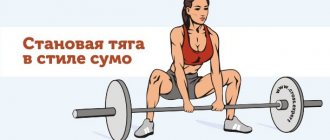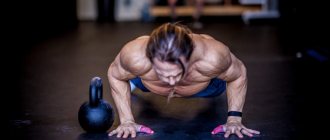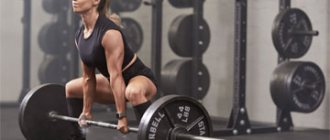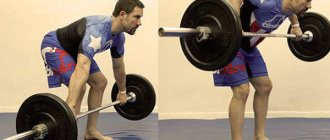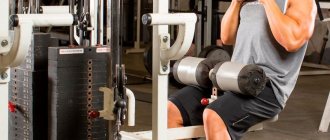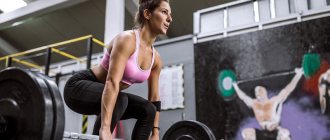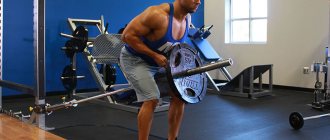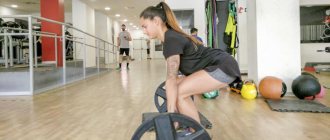The sumo deadlift is one of the main basic exercises in strength sports. The exercise is performed with a barbell and develops most muscle groups of the human body. Like any basic multi-joint exercise, the sumo deadlift must be performed with perfect technique, so you need to approach the exercise correctly, preparing the body muscles for heavy loads. Let's figure out what advantages the sumo deadlift has, how to perform it correctly, and how it differs from the classic deadlift.
Features and Benefits of the Sumo Deadlift
The peculiarity and main difference between sumo-style deadlifts and others is the wide placement of the feet. This technique allows you to connect and direct the load to the adductor muscles of the thigh, which is impossible to achieve when placing your feet shoulder-width apart, especially in the Romanian deadlift technique.
Due to the large distance between the feet, the amplitude of movement is reduced and the main part of the load falls not on the back, as in a classic deadlift, but on the quadriceps, adductors and gluteal muscles.
Before you start practicing
Before you start practicing this particular deadlift, you need to thoroughly study the technique of doing it. Deadlifts on straight legs do not tolerate inaccuracies in execution and frivolity in terms of selecting weights.
Therefore, before starting training, you need to sufficiently master the classic deadlift technique and achieve certain results in it.
Whatever the traction, it always requires special attention to fixing the back in a straight position. And it is this exercise that requires special attention and approach, since the angle between the torso and legs (that is, the ratio) is too large.
Alexander Shestov
TRX Certified Trainer
Ask a Question
If an athlete has had or has even minor back problems, before starting training, you should consult a doctor about the advisability and safety of such exercises for your own body.
It should be remembered that the deadlift on straight legs is based, first of all, on good stretching. If there is none, then such activities will be premature and even dangerous to your own health.
If an athlete, for example, is unable to touch the floor with his palms while standing on straight legs, then this will be the first point of a kind of unsuccessful stretching test. Without stretched Achilles tendons, nothing good will come of this venture.
To prevent this from happening, you need to prepare yourself properly by stretching for at least several weeks.
When training to improve stretching, you should not do deadlifts at the same time! And if you do do it, then only with minimal weights and only from an elevation.
The anatomical features of a particular athlete are also very important. In some cases, even with an ideal stretch, it is impossible to perform a deadlift without allowing the back to arch. Such cases require measures to reduce the amplitude of movements, that is, the initial height of the bar must be increased by any available means and methods.
The amplitude should be such that the back always remains straight, regardless of the phase of the movement.
Classic deadlift or sumo - which is better for girls and men
Even though both exercises are pulling exercises, they are essentially different exercises, just like squats and lunges. And each of the exercises is aimed at certain muscle groups, so the benefits and advantages of a particular exercise over another are measured in the need to work specific muscles. Let me explain.
- The classic deadlift develops to a greater extent the lumbar extensors and trapezius muscles, the quadriceps and gluteal muscles play a secondary role when pulling the barbell, so it is worth including this exercise in the training if it is necessary to develop the back muscles, it all depends on the specific goals and exercise program.
- The sumo deadlift should be included in the training process if there is a need for comprehensive development of the leg muscles, since the main part of the load is taken on by the quadriceps, adductors and gluteal muscles.
for male athletes to train strength using this technique, since the short amplitude allows them to perform strength movements with less energy expenditure. That is, it is easier to increase working weight in sumo than in classic.
For girls , the sumo deadlift technique has the advantage of working the muscles of the legs and buttocks, since the exercise involves almost all the muscles of the legs.
Varieties of grip
In the deadlift, grip is of no small importance, especially for professional athletes. For example, in powerlifting competitions they most often use a different grip (one palm outward, the other inward), which allows you to lift more weight. This grip is not recommended for beginners; a different grip in this case can cause spinal problems for the athlete. In the classic version of the deadlift, the grip is always straight (upper), it is also used taking into account jerks. Experienced athletes sometimes prefer a reverse grip, which allows them to develop maximum force. The width of the grip depends on the position of the legs, since the hands should not interfere with the exercise.
What muscles work in the sumo deadlift?
Main muscles:
- Quadriceps femoris muscles.
- Adductor muscles of the thigh.
- Gluteal muscles.
- Lumbar extensors.
Accessory muscles:
- Trapezius muscle.
- Latissimus dorsi muscles.
- Rhomboid muscle.
- Deltoid muscles.
- Pectoral muscles.
- Abdominal muscles.
- Forearms.
- Biceps.
Useful Features
The deadlift has many beneficial characteristics. As a compound exercise, this movement involves three joints, moving the hip, knee, and ankle joints, thereby using several large muscle groups (2). Compared to single exercises, complex movements involving multiple muscle groups result in a hormonal training response resulting in greater strength gains (1). Performing the actual deadlift can also lead to greater hypertrophy (1). The deadlift also has potential benefits for rehabilitation. It has been suggested that moderate to high levels of hamstring work may help protect the Anterior Cruciate Ligament during rehabilitation (2).
Deadlift movements are highly compatible with real life because... they simulate bending and lifting weights. Those who have toddlers are very familiar with the lifting motion.
Sumo barbell deadlift technique
Before performing a sumo deadlift, a high-quality and complete warm-up is necessary. This is necessary not only to warm up the muscles, but also to stretch them, increasing elasticity, preventing stretching of the muscles and ligaments of the adductor surface of the thigh.
Attention: an important condition for performing the sumo deadlift is good flexibility and elasticity of the adductor muscles; for this you should stretch regularly. Injuries, early sprains and stiffness of muscles and joints, especially pain when performing deadlifts, are contraindications to the exercise.
Preparing for the starting position
- Prepare a barbell with a suitable weight, placing it on the floor.
- Stand in front of the bar in the center, place your feet wide, turning your toes apart at 45 degrees.
- Squat down, moving your pelvis back so that your knees form a right angle and point in the direction of your knees. It is important to keep your back absolutely straight.
- Next, grab the bar with an overhand grip, shoulder-width apart.
- Lift the barbell off the floor without rounding your lower back or throwing your knees forward, fully extend your knees and torso.
Execution technique
- At the top, begin to inhale and gradually move your pelvis back, bending your knees to a right angle in the direction of your toes. The bar should be as close to the shin as possible, so as not to tilt the body too far forward and shift the center of gravity to the back. Lower the bar to the middle of your shin.
- From the bottom point, exhale, bend your knees, straightening them simultaneously with your torso. Constantly keep your spine straight by tensing your abdominal muscles and lumbar extensors.
Sumo deadlift technique in video format
Basic mistakes
- When performing deadlifts, you should not bend forward and take the entire load with your back. Here it is important to perform a squat, moving the pelvis back, while the back automatically bends forward, stabilizing the balance, the main thing is that the bar moves close to the shin.
- Do not lower the bar too low and touch the floor with it. The end point of the amplitude should end approximately in the middle of the lower leg. This will allow you to work more with your legs rather than your back due to the strong forward bend. At the same time, it is important to look in front of you without tilting your neck and head down.
- You don't need to put your feet too wide. The ideal position is one in which the knees reach a right angle at the lowest point of amplitude. If the muscles are inelastic, there is no need to place your legs so that your knees are not aligned with the vertical line of your shins and heels. You can, on the contrary, place your feet closer to each other, this will reduce the tension of the adductor muscles and ligaments, gradually moving the position of the feet away over time.
Training program tips
Let's discuss a couple more ways to get rid of back and lower back pain. Instead of holding out or raking painkillers off the drugstore shelves, go to the doctor and make your workout safer and easier. Although even if nothing hurts you now, it’s better to use these tips. Some of them will come in handy both in the gym and outside of it.
- If it hurts, don't do it - look for a similar alternative exercise..
Any sports doctor will tell you that if an exercise is accompanied by pain, it is better not to do it. But this does not mean that you will have to abandon ALL such movements. Look for different variations. Yes, if your knees really hurt, then you CANNOT squat. No way. At all.
Neither sumo nor (ESPECIALLY) plié . Go to a doctor and find out from him, and not from fitness instructors, who themselves are often not in the know.
